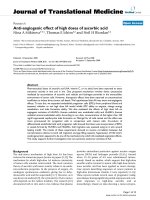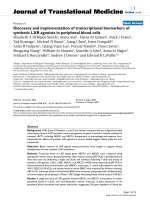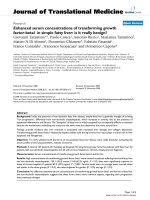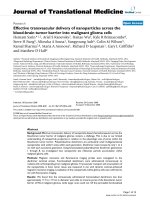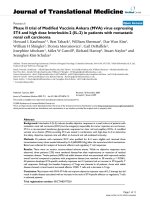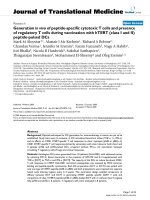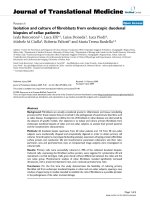báo cáo hóa học: " Fractional Langevin model of gait variability" pdf
Bạn đang xem bản rút gọn của tài liệu. Xem và tải ngay bản đầy đủ của tài liệu tại đây (354.16 KB, 9 trang )
BioMed Central
Page 1 of 9
(page number not for citation purposes)
Journal of NeuroEngineering and
Rehabilitation
Open Access
Research
Fractional Langevin model of gait variability
Bruce J West*
1
and Miroslaw Latka
2
Address:
1
Mathematical and Informational Sciences Directorate US Army Research Office, P.O. Box 12211 Research Triangle Park, NC 27709, USA
and
2
Physics Department Wroclaw University of Technology Wybrzeze Wyspianskiego 27, 50-370 Wroclaw, Poland
Email: Bruce J West* - ; Miroslaw Latka -
* Corresponding author
Abstract
The stride interval in healthy human gait fluctuates from step to step in a random manner and
scaling of the interstride interval time series motivated previous investigators to conclude that this
time series is fractal. Early studies suggested that gait is a monofractal process, but more recent
work indicates the time series is weakly multifractal. Herein we present additional evidence for the
weakly multifractal nature of gait. We use the stride interval time series obtained from ten healthy
adults walking at a normal relaxed pace for approximately fifteen minutes each as our data set. A
fractional Langevin equation is constructed to model the underlying motor control system in which
the order of the fractional derivative is itself a stochastic quantity. Using this model we find the
fractal dimension for each of the ten data sets to be in agreement with earlier analyses. However,
with the present model we are able to draw additional conclusions regarding the nature of the
control system guiding walking. The analysis presented herein suggests that the observed scaling in
interstride interval data may not be due to long-term memory alone, but may, in fact, be due partly
to the statistics.
Background
One strategy for understanding legged locomotion of ani-
mals is through the use of a Central Pattern Generator
(CPG), an intraspinal network of neurons capable of pro-
ducing a syncopated output [1]. The implicit assumption
in such an interpretation is that a given limb moves in
direct proportion to the voltage generated in a specific
part of the CPG. As Collins and Richmond [1] point out,
in spite of the studies establishing the existence of a CPG
in the central nervous system of quadrupeds, such direct
evidence does not exist for a vertebrate CPG for legged
locomotion. Consequently, these and other authors have
turned to the construction of models, based on the cou-
pling of linear and nonlinear oscillators, to establish that
the mathematical models are sufficiently robust to mimic
the locomotion characteristics observed in the move-
ments of segmented bipeds [2], as well as in quadrupeds
[3]. These characteristics, such as the switching among
multiple gait patterns, is shown to not depend on the
detailed dynamics of the constituent nonlinear oscilla-
tors, nor on their inter-oscillator coupling strengths [1]. A
nonlinear stochastic model of the dynamics of the human
gait motor control system called the super CPG (SCPG)
has been developed [4]. In the SCPG the stride interval
time series is shown to be slightly multifractal, with a frac-
tal dimension that is sensitive to physiologic stress.
Herein we do not focus on the generation of each step
during walking, but rather we examine the variation in
successive steps and its underlying structure.
It has been known for over a century that there is a varia-
tion in the stride interval of humans during walking of
Published: 02 August 2005
Journal of NeuroEngineering and Rehabilitation 2005, 2:24 doi:10.1186/1743-0003-2-24
Received: 12 April 2005
Accepted: 02 August 2005
This article is available from: />© 2005 West and Latka; licensee BioMed Central Ltd.
This is an Open Access article distributed under the terms of the Creative Commons Attribution License ( />),
which permits unrestricted use, distribution, and reproduction in any medium, provided the original work is properly cited.
Journal of NeuroEngineering and Rehabilitation 2005, 2:24 />Page 2 of 9
(page number not for citation purposes)
approximately 3–4%. This random variability is so small
that the biomechanical community has historically con-
sidered these fluctuations to be an uncorrelated random
process, such as might be generated by a simple random
walk. In practice this means that the fluctuations in gait
were thought not to contain any useful information about
the underlying motor control process. On the other hand,
Hausdorff et al. [5,6] demonstrated that stride-interval
time series exhibit long-time correlations, and suggested
that the phenomenon of walking is a self-similar fractal
activity. Subsequent studies by West and Griffin [7-9] sup-
port these conclusions using a completely different exper-
imental protocol for generating the stride-interval time
series data and very different methods of analysis. It was
found that things are not quite that simple, however, and
instead of the process having no characteristic time scale,
as would be the case for a monofractal, there is a prefer-
ence for a multiplicative time scale in the physiological
control system [7].
Physiological time series invariably contain fluctuations
so that when sampled N times the data set {X
j
}, j = 1, ,
N, appear to be a sequence of random points. Examples of
such data are the interbeat intervals of the human heart
[10,11], interstride intervals of human gait [5,9], brain
wave data from EEGs [12] and interbreath intervals [13],
to name a few. The analysis of the time series in each of
these cases has made use of random walk concepts in both
the analysis of the data and in the interpretation of the
results. For example, the mean-square value of the dynam-
ical variable in each of these cases (and many more) have
the form ΌX(t)
2
∝ t
δ
, where
δ
≠ 1 corresponds to "anoma-
lous diffusion". A value of
δ
< 1 is often interpreted as an
antipersistent process in which a step in one direction is
preferentially followed by a step reversal. A value of
δ
> 1
is often interpreted as a persistent process in which a step
in one direction is preferentially followed by another step
in the same direction. A value of
δ
= 1 is, again, often inter-
preted as ordinary diffusion in which the steps are inde-
pendent of one another. The initial analysis of each of
these time series, using random walk concepts, suggested
that they could be interpreted as monofractals. However,
on further investigation the heart beat variability has been
found to be multifractal [14], as were the interstride inter-
vals [4].
A modeling approach complementary to random walks is
the Langevin equation, a stochastic equation of motion
for the dynamical variables in a physical system. This lat-
ter model has undergone a transformation similar to that
of random walks since its introduction into physics by
Langevin in 1908. The solution to the Langevin equation
is a fluctuating trajectory for the particle of interest and an
ensemble of such trajectories determines the statistical
distribution function. In this way the Gaussian probabil-
ity density for Brownian motion is obtained. The density
can also be obtained by aggregating the steps to form a
discrete trajectory using a random walk model [15,16].
These two kinds of models of the physical world, random
walks and the Langevin equation, have long been thought
to be equivalent. In fact, that equivalence has been used as
the dynamical foundation of statistical mechanics and
thermodynamics. This equivalence has also been used to
interpret the monofractal statistical properties of physio-
logical time series.
While the properties of monofractals are determined by
the global scaling exponent, there exists a more general
class of heterogenous signals known as multifractals which
are made up of many interwoven subsets with different
local scaling exponents h. The statistical properties of these
subsets may be characterized by the distribution of fractal
dimensions f(h). In order to describe the scaling proper-
ties of multifractal signals it is necessary to use many local
Hölder exponents. Formally, the Hölder exponent h(t
0
) of
a trajectory X(t) at t = t
0
is defined as the largest exponent
such that there exists a polynomial P
n
(t) of order n that
satisfies the following condition [17]:
for t in a neighborhood of t
0
and the symbol O(
ε
) means
a term no greater than
ε
. Thus the Hölder exponent meas-
ures the singularity of a trajectory at a given point. For
example, h(t
0
) = 1.5 implies that the trajectory X is differ-
entiable at t
0
but its derivative is not. The singularity lies in
the second derivative of X(t). The singularity spectrum
f(h) of the signal may be defined as the function that for a
fixed value of h yields the Hausdorff dimension of the set
of points t. The singularity spectrum is used to determine
whether or not the stride interval time series is
multifractal.
A new kind of random walk has recently been developed,
one having multifractal properties [18-21]. Herein we are
guided by this earlier work, but use it to generalize the
Langevin equation to describe a multifractal dynamical
phenomenon. In Methods we review the multifractal for-
malism and apply the processing algorithm to the inter-
stride interval time series. The mass exponent
τ
(q) is
determined to be a nonlinear function of the moment q,
and the singularity spectrum f(h) is found to be a convex
function of local scaling exponent h. We also introduce a
fractional Langevin equation and make the index of a frac-
tional integral a random variable to show how this model
can describe a multifractal process. The multifractal spec-
trum is shown to be a property of the solution to this
fractional Langevin equation. In Results and Disscussion we
apply the analytic expression for the singularity spectrum
Xt P t t t t
n
ht
() ( ) ()
()
−−= −
(
)
00
0
1
Ο
Journal of NeuroEngineering and Rehabilitation 2005, 2:24 />Page 3 of 9
(page number not for citation purposes)
to the interstride interval data discussed in the Methods
section. The agreement between the predictions of the
fractional Langevin equation and experiment for human
gait is remarkable. In Conclusions we explore some of the
physiological implications of the fractional Langevin
model including the suggestion that the observed scaling
of the time series may not only be due to long-term mem-
ory but to the underlying statistics as well.
Methods
The distribution of Hölder exponents for a time series can
be determined in a number of different ways. Herein we
use the partition function. Let us cover the time axis with
cells of size
δ
such that the time is given by t = N
δ
and N
> > 1. Following Falconer [17] we can define the partition
function in terms of the moments, q, of a measure µ
where B
j
is the j
th
box in the δ-coordinate mesh that inter-
sect with the measure µ. We can construct the measure
using the time series obtained from the interstride interval
data. This measure is made by aggregating the observed
interstride time intervals, t
j
, j = 1,2 , N,
such that T(n,
δ
) is interpreted as the random walk trajec-
tory for a given data set. We use the random walk trajec-
tory to construct the phenomenological measure in the
partition function (2) as
where the integer n is the discrete time lag. For a monof-
ractal random walk process the measure (4) is essentially
uniform. For a multifractal, on the other hand, the theo-
retical scaling behavior of the partition function S
q
(
δ
) in
the limit of vanishing grid scale [17,24] is
S
q
(δ) ≈ δ
-τ(q)
(5)
where
τ
(q) defines the mass exponent. We emphasize that
(4) is a phenomenological measure with an undeter-
mined lag time. The lag time is chosen in the present cal-
culation to maximize the sensitivity of the partition
function to the positive moments.
The mass exponent is related to the generalized dimen-
sion D(q) by the relation
τ(q) = (1 - q)D(q) (6)
where D(0) is the fractal or box-counting dimension,
D(1) is the information dimension and D(2) is the corre-
lation dimension [24]. The moment q therefore accentu-
ates different aspects of the underlying dynamical process.
For q > 0, the partition function S
q
(
δ
) emphasizes large
fluctuations and strong singularities through the general-
ized dimensions, whereas for q <0, the partition function
stresses the small fluctuations and the weak singularities.
This property of the partition function deserves a caution-
ary note because the negative moments can easily become
unstable, introducing artifacts into the calculation. For
this reason the interpretation of the trajectory approach
must be judged with some caution for q < 0.
A monofractal time series can be characterized by a single
fractal dimension. In general, time series have a local frac-
tal exponent h that varies over the course of the trajectory.
The function f(h), called the multifractal or singularity
spectrum, describes how the local fractal exponents con-
tribute to such time series. Here h and f are independent
variables, as are q and
τ
. The general formalism of Legen-
dre transform pairs interrelates these two sets of variables
by the relation, using the sign convention in Feder [24],
f(h) = qh + τ(q). (7)
The local Hölder exponent h varies with the q-dependent
mass exponent through the equality
so the singularity spectrum can be written as
f(h(q)) = - qτ'(q) + τ(q) (9)
where
τ
(q) is determined by data, that is, by the trajectory,
as is its derivative
τ
'(q).
The multifractal behavior of time series can be modeled
using a number of different formalisms. For example, a
random walk [19,23], in which a multiplicative coeffi-
cient in the random walk is itself made random, becomes
a multifractal process. This approach was developed long
before the identification of fractals and multifractals and
may be found in Feller's book [25] under the heading of
subordination processes. The multifractal random walks
have been used to model various physiological phenom-
ena. Another method, one that involves an integral kernel
with a random parameter, was used to model turbulent
fluid flow [26]. Here we adopt a version of the integral
kernel, but one adapted to time rather than space series. In
SB
qj
q
j
() ()δµ=
()
∑
2
Tn t
j
j
n
(,) ()δ=
=
∑
1
3
µ
δδ
δδ
B
Tj n Tj
Tk n Tk
j
k
Nn
()
=
+−
+−
=
−
∑
(,)(,)
(,)(,)
()
1
4
hq
dq
dq
q()
()
’( ) ( )=− =−
τ
τ 8
Journal of NeuroEngineering and Rehabilitation 2005, 2:24 />Page 4 of 9
(page number not for citation purposes)
order to accomplish this we review some of the history of
the Langevin equation.
Fractional Langevin equation
A theoretical Langevin equation is generally constructed
from a Hamiltonian model for a simple dynamical system
coupled to the environment [27]. The equations of
motion for the coupled system are manipulated so as to
eliminate the degrees of freedom of the environment from
the dynamical description of the system. Only the initial
state of the environment (heat bath) remains in the Lan-
gevin description, where the random nature of the driving
force is inserted through the choice of distribution of the
initial states of the bath. The simplest Langevin equation
for a dynamical system open to the environment has the
form
where
ξ
(t) is a random process, λ is a dissipation parame-
ter and there exists a fluctuation-dissipation relation [27]
connecting the two. Of course, we cannot completely
interpret (10) until we specify the statistical properties of
the
ξ
-fluctuations and for this we need to know the envi-
ronment of the system. The random driver is typically
assumed to be a Wiener process, that is, to have Gaussian
statistics and no memory.
When the system dynamics depends on what occurred
earlier, that is, the environment has a memory, (10) is no
longer adequate and the Langevin equation must be mod-
ified. The generalized Langevin equation takes this mem-
ory into account through an integral term of the form
where the memory kernel, K(t), replaces the dissipation
parameter and there is a generalized fluctuation-dissipa-
tion relation [27]. Both these Langevin equations are
monofractal if the fluctuations are monofractal, which is
to say the time series given by the trajectory X(t) is a fractal
random process, if
ξ
(t) is a fractal random process.
Now we come to the most recent generalization of the
Langevin equation, one that incorporates memory into
the system's dynamics through the use of fractional calcu-
lus. The simplest fractional Langevin equation has the
form [28]
where is a Riemann-Liouville (RL) fractional deriva-
tive with 0 < β ≤ 1
and is related to the RL-fractional integral
Note that we have not included dissipation in this simple
model, but the initial condition X
0
= X(0) is incorporated
into the dynamical equation in order to have a well-
defined initial value problem. The formal solution to the
fractional Langevin equation (12) is [28]
where the kernel in (15) is given by the weighting factor
within the RL-fractional integral. As mentioned earlier,
the form of this relation for multiplicative stochastic proc-
esses and its association with multifractals had been noted
in the phenomenon of turbulent fluid flow [26], through
a space, rather than time, integration kernel.
Multifractal time series
The random forcing term on the right-hand side of (15) is
selected to be a zero-centered, Gaussian random variable
and therefore to scale as [29]
ξ(λt) = λ
h
ξ(t) (16)
where the Hölder exponent is in the range 0 <h = 1. In a
similar way the kernel in (15) is easily shown to scale as
K
β
(λt) = λ
β-1
K
β
(t) (17)
so that the solution to the fractional Langevin equation
scales as
∆X(λt) = λ
h+β
∆X(t) (18)
where ∆X(t) = X(t) - X
0
. In order to make the solution to
the fractional Langevin equation a multifractal we assume
that the parameter β is random. To construct the tradi-
tional measures of multifractal stochastic processes we
calculate the q
th
moment of the solution by averaging over
both the random force ξ and the random parameter β to
obtain, in an obvious notation,
dX t
dt
Xt t
()
() () ( )+=λξ 10
dX t
dt
Kt t Xt dt t
t
()
(’)(’)’() ()+− =
∫
ξ
0
11
DXt
t
Xt
t
β
β
β
ξ()
()
() ( )
[]
+
−
=
−
Γ 1
12
0
D
t
β
DXt
Xt dt
tt
t
t
β
β
β
()
()
(’) ’
(’)
()
[]
=
−
−
+
∫
1
13
1
0
Γ
DXt
Xt dt
tt
t
t
−
−
[]
=
−
−
∫
β
β
β
()
()
(’) ’
(’)
()
1
1
14
1
0
Γ
Xt X
tdt
tt
Ktt tdt
t
()
()
(’) ’
(’)
( ’)(’) ’ ( )−=
−
−
=−
−
∫∫
0
1
0
1
1
15
Γβ
ξ
ξ
β
β
Journal of NeuroEngineering and Rehabilitation 2005, 2:24 />Page 5 of 9
(page number not for citation purposes)
Note that when ζ(q), the structure function exponent, is
linear in q the underlying process is monofractal, whereas,
when ζ (q) is nonlinear in q the proces is multifractal. This
is the case because
ζ(q) = 1 - τ(q) (20)
relating the structure function exponent to the mass expo-
nent [30].
To determine the structure function exponent we make an
assumption about the statistics of the parameter β. We can
always write the β-average as
where Z(s) is a random variable as well as a function of s.
Note that in the present case the functionality is just one
of linear proportionality. In this way the expression on the
right-hand side of (21) is the Laplace transform of the
probability density. We assume the random variable Z(s)
is an α-stable Lévy process in which case the statistics of
the multiplicative fluctuations are given by the distribu-
tion [15]
with 0 < α = 2. Inserting (22) into (21) to replace the aver-
aging bracket and integrating over z yield the delta func-
tion
δ
(k+iq) which, integrating over k, results in
so that re-introducing s = ln
λ
into this equation we obtain
Consequently, from (20) we obtain for the moment cor-
relation function
ζ(q) = qh - b|q|
α
(23)
Therefore the solution to the fractal Langevin equation
corresponds to a monofractal process only in the case α =
1 and q > 0, otherwise the process is multifractal. We
restrict the remaining discussion to q > 0.
Thus, we observe that when the memory kernel in the frac-
tional Langevin equation is random, the solution consists
of the product of two random quantities giving rise to a
multifractal statistical process. This is analogous to Feller's
subordination process. We observe that, for the statistics
of the multiplicative exponent given by Lévy statistics, the
singularity spectrum as a function of the positive
moments, is
f(q) = 1 - (α - 1)bq
α
(25)
which is determined by substituting (24) into (9),
through the relationships between exponents (20).
Results and Discussion
The data obtained, from individuals walking at a normal
steady pace, consists of the time interval for each stride
and the number of strides in a sequence of steps. The max-
imal extension of the right leg, the "stride interval" versus
the stride number, plotted on a graph, has all the charac-
teristics of a time series, cf. Figure 1. There were ten partic-
ipants in the study (four males and six females), all in
good health, with no acute injuries, ranging in age from
20 to 46 years old with a median age of 29 years. Normal
steady walking was monitored for the ten participants,
and an electrogoniometer was used to collect kinematic
data on the angular extension of the right leg. The signal
from the electrogoniometer was recorded at 100 Hz by a
computer contained in a "fanny pank" attached to the
walker. These data were downloaded to a PC after twelve
to fifteen minutes and the interval between successive
maximal extensions of the right leg in the analog signal
was digitized and used as the time series data [7].
∆∆∆X t Xt Xt
q
qh q
q
q
q
( ) () () . ( )
,
()
λλλ λ
ξβ
β
β
ξ
ζ
ξ
== 19
λ
β
β
λqqZ
z
e=
(ln )
()21
Pzs e e dk
ikz
bs k
(,) ( )=
−
−∞
∞
∫
1
2
22
π
α
eePzsdze
qZ s
z
qz
bs q
()
(,)==
∞
−
∫
0
α
e
qZ
z
bq
(ln )
()
λ
λ
α
=
−
23
Typical interstride interval time seriesFigure 1
Typical interstride interval time series: The interstride
interval time series for a person undergoing relaxed walking
is depicted for 800 steps. This is taken from a 15 minute time
series [7].
Journal of NeuroEngineering and Rehabilitation 2005, 2:24 />Page 6 of 9
(page number not for citation purposes)
The signal shown in Figure 1 indicates a variation in the
stride interval with a standard deviation of 0.12 seconds,
and the resolution of the measurement is of the order 0.01
seconds. What can we learn from a time series that has
such a potentially substantial error? Suppose our time
series consists of the superposition of two independent
processes. One process is determined by the dynamics of
the system and the other by measurement error, so that
the second moment of the time series after n intervals is
given by
<X(t)
2
> = An + Bn
δ
(26)
The first process is, of course, that due to measurement
error, modeled as a simple random walk, with strength A.
For
δ
> 1 the second process is a persistent random walk
and dominates for n > 1. In such a case we would expect
for n sufficiently large, where the relative size of A and B
determines what is meant by sufficiently large, to find the
scaling
<X(λt)
2
> ≈ λ
δ
<X(t)
2
>. (27)
This scaling was, in fact, observed for the data depicted in
Figure 1, as well as for the other gait time series obtained
in this study [7-9]. From the results of these earlier analy-
ses we conclude that the level of statistical variation in the
data, due to measurement error, will not change the con-
clusions drawn from subsequent analysis.
As mentioned above, a time series is monofractal when
the mass exponent
τ
(q) is linear in q, otherwise the under-
lying process is multifractal. We apply the partition func-
tion measure and numerically evaluate
and the results are depicted in Figure 2a. Rigorously, the
expression for the mass exponent requires
δ
→ 0, but we
cannot do that with the data, so there is some error in our
results. The significance of that error is to be determined.
In Figure 2a we only show the mass exponent for a typical
walker from the ten subjects, since they individually do
not look too different from the curve shown. It is clear
from the figure that the mass exponent is not linear in the
moment index q. In Table 1 we record the fitting coeffi-
cients for each of the ten time series using the fitting equa-
tion for the mass exponent suggested by the solution to
the fractional Langevin equation,
τ(q) = 1 + a
1
q + a
2
|q|
α
. (29)
The fit to the data using (29) is indicated by the solid
curve in Figure 2a.
The singularity spectrum can now be determined using
the Legendre transformation by at least two different
methods. One procedure is to use the fitting equation sub-
stituted into (9). We do not do this here, but we note in
passing that if (29) is inserted into (8), the fractal dimen-
sion is determined by the q = 0 moment to be
The values of the parameter a
1
listed in Table 1 agree with
the fractal dimensions obtained earlier using a scaling
argument for the same data [7].
A second method for determining the singularity spec-
trum, the one we use here, is to numerically determine
τ
δ
()
ln ( )
ln
()q
S
q
q
=− 28
Empirical mass exponent and singularity spectrumFigure 2
Empirical mass exponent and singularity spectrum:
(a) The mass exponent is determined using the partition
function from (28) and given by the dots for a typical data
set. The solid curve is the quadradic least-squares fit of (29)
to the calculated points. (b) The singularity spectrum is
determined from the mass exponent using (9).
h
dq
dq
a
q
()
()
.()030
0
1
=− =−
=
τ
Journal of NeuroEngineering and Rehabilitation 2005, 2:24 />Page 7 of 9
(page number not for citation purposes)
both
τ
(q) and its derivative. In this way we calculate the
multifractal spectrum directly from the data using (9). It is
clear from Figure 2b that we obtain the canonical form of
the spectrum, that is, f(h) is a convex function of the scal-
ing parameter h. The peak of the spectrum is determined
to be the fractal dimension, as it should. Here again we
have an indication that the interstride interval time series
describes a multifractal process, but we stress that we are
only using the qualitative properties of the spectrum for q
> 0, due to the sensitivity of the numerical method to
weak singularities. This sensitivity is apparent from the
asymmetry of the empirical singularity spectrum in Figure
2b. These results are in agreement with the weak multi-
fractality found by Scafetta et al. [31] using a different
interstride interval data set.
It is clear from Figure 3 that the singularity spectrum cal-
culated from the data for positive q are well fit by the solu-
tion to the fractional Langevin equation with the
parameter values α = 1.57 and a
2
= 0.13, obtained through
a mean-square fit of (25) to the data points. Note that this
fit to the scaling exponent is denoted as the empirical Lévy
index in Table 1. Adjacent to this column is the theoretical
Lévy index obtained from the relation
called the Lévy-walk diffusion relation [32] and which
relates the scaling exponents when the underlying statisti-
cal process is an α-stable Lévy statistical process. Note that
the Lévy probability density p(x, t) satisfies the scaling
relation [32]
A comparison of the two columns for the Lévy index in
Table 1, empirical and theoretical, using a statistical t-test,
indicates statistical significance at the p = 0.01 level.
Conclusion
The nonlinear form of the mass exponent
τ
(q) in Figure
2a, the convex form of the singularity spectrum f(h) in Fig-
Table 1: The fitting parameters for the mass exponent
τ
(q) are listed. The column-a
1
is the fractal dimension for the time series. In
each case the fractal dimension agrees with that obtained earlier using a different method [7]. The last two columns denote the Lévy
index and the statistical significance of the comparison of the empirical and theoretical values is p = 0.01
Walker -a
1
a
2
Empirical Lévy index Theoretical Lévy index
1 1.26 0.13 1.57 1.52
2 1.41 0.19 1.57 1.82
3 1.32 0.09 1.83 1.64
4 1.26 0.24 1.54 1.52
5 1.12 0.28 1.47 1.24
6 1.07 0.07 1.84 1.14
7 1.17 0.07 1.69 1.34
8 1.29 0.27 1.39 1.58
9 1.14 0.12 1.63 1.28
10 1.17 0.12 1.64 1.34
Averages 1.21 ± 0.10 0.15 ± 0.07 1.61 ± 0.15 1.44 ± 0.21
µ
α
=
−
=
1
32
1
31
h
()
Singularity spectum in terms of momentsFigure 3
Singularity spectum in terms of moments: The singu-
larity spectrum is calculated as a function of the moment-
order and denoted by the dots using (9) for a typical data set.
The solid curve is the least-squares fit of (29) to the calcu-
lated points.
pxt t F
x
t
(,) . ( )=
µ
µ
32
Journal of NeuroEngineering and Rehabilitation 2005, 2:24 />Page 8 of 9
(page number not for citation purposes)
ure 2b and the fit to f(q) in Figure 3, are all indications
that interstride interval time series are multifractal. This
analysis is further supported by the fact that the maxima
of the singularity spectra coincide with the fractal dimen-
sions determined previously using the scaling properties
of the time series without the construction of a random
walk trajectory [7]. A complete discussion of the limita-
tions associated with determining the multifractal nature
of interstride intervals using the singularity spectrum with
limited data is given by Scafetta et al [31]. Furthermore,
the empirical values of the Lévy index in Table 1 are
consistent with those predicted using Lévy-walk diffusion
relation [32] at the 0.01 level of significance.
It has been suggested that the CPG for gait consists of a
random walk among a number of neural centers, thereby
giving rise to its fractal behavior [5,6]. This model gives
rise to a process having Gauss statistics and a long-time
memory determined by the scaling index. The present
results, however, point in a different direction. Recall that
anamolous diffusion (δ ≠ 1) can arise in two distinct ways.
The more familiar is that of a random walk with memory,
in which the statistics are Gaussian, but the frequency
spectrum is given by P(ω) ∝ 1/ω
δ-1
. The second way anom-
alous diffusion can arise is through the scaling of the
probability density as given by (32). If the statistics are
Gaussian then the scaling indices are related by δ = 2 µ and
for ordinary diffusion µ = 1/2 impling δ = 1; in addition,
for µ ≠ 1/2 the process is that of fractional Brownian
motion. However, when the statistics are Lévy stable the
second moment diverges and special methods must be
employed to obtain second-moment scaling.
Shlesinger et al.[33] showed that when the steps in a ran-
dom walk can be arbitrarily long and the length of time
required to take a step is accounted for in the walking
process, one obtains a Lévy diffusion process with a finite
second moment. The second moment in such a Lévy-walk
has a scaling index given by (31) with
δ
= 1/
α
. Conse-
quently, the quality of the fit of the Lévy index obtained
using the Lévy-walk diffusion relation to that obtained
from the singularity spectrum, given by the solution to the
fractional Langevin equation, suggests that the scaling in
the interstride interval data may not be due solely to long-
term memory, as previous investigators have concluded.
Instead the observed scaling in interstride interval time
series might be due to both long-time memory and
statistics.
We use the fractional Langevin equation to describe the
motor control process rather than the random walks of
previous authors because of the direct correspondence
between the microscopic dynamics and the macroscopic
fractional derivatives established by Grigolini et al. [34].
The latter authors demonstrate that the existence of a clear
separation between microscopic and macroscopic time
scales supports the use of random walks and traditional
statistical mechanics to model the phenomena of interest.
This separation of time scales would be consistent with
the traditional random walk way of modeling memory in
CPG. However, when the microscopic time scales diverge,
such that they overlap with the macroscopic time scale,
ordinary statistical mechanics breaks down and the non-
differentiabiltiy of the microscopic dynamics is transmit-
ted from the microscopic to the macroscopic level in the
form of fractional derivatives. In the present context a
manifestation of an inverse power-law distribution of
neuron firing would be a fractional differential equation
of motion for motor response.
Stated somewhat differently, Grigolini et al [34] showed
that the fractional derivative in the fractional Langevin
equation can be interpreted in terms of an inverse power-
law waiting time distribution function using a Continu-
ous Time Random Walk Model. Thus, not only is the fre-
quency accessed by the control system selected randomly,
but the length of time it spends at that particular fre-
quency in SCPG is also random. This waiting time distri-
bution function is inverse power law and directly
proportional to the fractional integral kernel. The
fractional Langevin equation implies this full dynamical
picture and appears to be consistent with the human gait
data.
We are cognizant of the fact that to establish that the scal-
ing observed in interstride interval data is due to statistics
and memory, rather than long-time memory alone,
requires more than the limited analysis presented here. So
we put this speculation in the form of a hypothesis which
we are presently testing using extensive interstride interval
data available from Physionet. The results of these tests will
be presented elsewhere.
Additional material
Acknowledgements
The authors thank the U.S. Army Research Office for partial support of this
research and Dr. L. Griffin for providing the data used in this analysis and
for useful discussions.
Additional File 1
List of symbols used.
Click here for file
[ />0003-2-24-S1.doc]
Publish with BioMed Central and every
scientist can read your work free of charge
"BioMed Central will be the most significant development for
disseminating the results of biomedical researc h in our lifetime."
Sir Paul Nurse, Cancer Research UK
Your research papers will be:
available free of charge to the entire biomedical community
peer reviewed and published immediately upon acceptance
cited in PubMed and archived on PubMed Central
yours — you keep the copyright
Submit your manuscript here:
/>BioMedcentral
Journal of NeuroEngineering and Rehabilitation 2005, 2:24 />Page 9 of 9
(page number not for citation purposes)
References
1. Collins JJ, Richmond SA: Hard-wired central pattern generators
for quadrupedal locomotion. Biological-Cybernetics 1994,
71:375-385.
2. Cohen AH, Rossignol S, Grillner S: Neural control of rhythmic move-
ments in vertebrates New York: Wiley; 1988.
3. Collins JJ, Stewart IN: Coupled nonlinear oscillators and the the
symmetries of animal gait. J Nonlinear Sci 1993, 3:349-392.
4. West BJ, Scafetta N: Nonlinear dynamical model of human gait.
Phys Rev E 2003, 67:051917-1.
5. Hausdorff JM, Peng CK, Ladin Z, Wei JY, Goldberger AL: Is walking
a random walk? Evidence for long-range correlations in
stride interval of human gait. J Appl Physiol 1995, 78:349-358.
6. Hausdorff JM, Mitchell SL, Firtion R, Peng CK, Cudkowicz ME, Wei JY,
Goldberger AL: Altered fractal dynamics of gait: reduced
stride-interval correlations with aging and Huntington's
disease. J Appl Physiol 1997, 82:262-269.
7. Griffin L, West DJ, West BJ: Random stride intervals with
memory. J Biol Phys 2000, 26:185-202.
8. West BJ, Griffin L: Allometric control of human gait. Fractals
1998, 6:101-108.
9. West BJ, Griffin L: Allometric control, inverse power laws and
human gait. Chaos, Solitons & Fractals 1999, 10:1519-1527.
10. West BJ, Zhang R, Sanders AW, Miniyar S, Zuckerman JH, Levine BD:
Fractal fluctuations in transcranial Doppler signals. Physical
Review E 1999, 59:3492-3498.
11. Peng CK, Mietus JE, Hausdorff JM, Havlin S, Stanley HE, Goldberger
AL: Long-range anticorrelations and non-Gaussian behavior
of the heartdeat. Phys Rev Lett 1993, 70:1343-1346.
12. West BJ: Physiology, Promiscuity and Prophecy at the Millennium: A Tale of
Tails World Scientific, Singapore; 1999.
13. Szeto HH, Cheng PY, Decena JA, Cheng Y, Wu DL, Dwyer G: Frac-
tal properties in fetal breathing dynamics. Am J Physiol 1992,
263:R141-R147.
14. Ivanov PC, Amaral LA, Goldberger AL, Havlin S, Rosenblum MG,
Stanley HE, Struzik ZR: Multifractality in human heartbeat
dynamics. Nature 1999, 399:461-465.
15. Montroll EW, West BJ: An Enriched Collection of Stochastic
Processes. In Fluctuation phenomena, Pbk. ed., updated edn Edited by:
Montroll EW, Lebowitz JL. Amsterdam: North-Holland; 1987:61-206.
16. Weiss GH: Aspects and applications of the random walk Amsterdam:
North-Holland; 1994.
17. Falconer KJ: Fractal geometry mathematical foundations and applications
Chichester: Wiley; 1990.
18. Muzy JF, Bacry E, Arneodo A: Wavelets and multifractal formal-
ism for singular signals: Application to turbulence data. Phys-
ical Review Letters 1991, 67:3515-3518.
19. Muzy JF, Bacry E, Arneodo A: Multifractal formalism for fractal
signals: The structure-function approach versus the wavelet-
transform modulus-maxima method. Phyical Review E 1993,
47:875-884.
20. Castaign B, Gagne Y, Hopfinger E: Velocity probability density-
functions of high Reynolds-number turbulence. Physica D
1990, 46:177-200.
21. Mallat SG: A Wavelet Tour of Signal Processing 2nd edition. Cambridge:
Academic Press; 1999.
22. Ashkenazy Y, Hausdorff JM, Ivanov PCh, Goldberger AL, Stanley HE:
A stochastic model of human gait dynamics. Physica A 2002,
316:662-670.
23. Schmitt FG, Seuront L: Multifractal random walk in Copepod
behavior. Physica A 2001, 301:375-396.
24. Feder J: Fractals New York: Plenum Press; 1988.
25. Feller W: An introduction to probability theory and its applications 3rd edi-
tion. New York: Wiley; 1967.
26. Schertzer D, Lovejoy S, Schmit F, Chiguirinskaya Y, Marsan D: Multi-
fractal cascade dynamics and turbulent intermittency. Frac-
tals 2005, 5:427-471.
27. Lindenberg K, West BJ: The nonequilibrium statistical mechanics of open
and closed systems New York: VCH Publishers; 1990.
28. West BJ, Grigolini P, Bologna M: Physics of Fractal Operators New
York:Springer; 2004.
29. Bassigthwaighte B, Liebowitch LS, West BJ: Fractal Physiology Oxford:
Oxford University press; 1994.
30. Rajagopalan B, Tarboton DG: Understanding complexity in the
structure of rainfall. Fractals 1993, 1:606-616.
31. Scafetta N, Griffin L, West BJ: Holder exponent spectra for
human gait. Physica A 2003, 328:561-583.
32. Scafetta N, West BJ: Mutiscaling comparative analysis on
"earthquake conversations" in California:. Phys Rev Lett 2004,
92:138501-1-138501-4.
33. Shlesinger MF, West BJ, Klafter J: Lévy dynamics for enhanced
diffusion: an application to turbulence. Phys Rev Lett 1987,
58:1100-1103.
34. Grigolini P, Rocco A, West BJ: Fractional calculus as a macro-
scopic manifestation of randomness. Phys Rev E 1999,
59:2603-2613.
